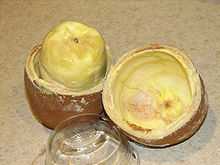Cupuaçu
| Cupuaçu | |
|---|---|
 | |
| Scientific classification | |
| Kingdom: | Plantae |
| (unranked): | Angiosperms |
| (unranked): | Eudicots |
| (unranked): | Rosids |
| Order: | Malvales |
| Family: | Malvaceae |
| Genus: | Theobroma |
| Species: | T. grandiflorum |
| Binomial name | |
| Theobroma grandiflorum (Willd. ex Spreng.) K.Schum. | |
Cupuaçu (Theobroma grandiflorum), also spelled cupuassu, cupuazú, cupu assu, and copoasu, is a tropical rainforest tree related to cacao.[1] Common throughout the Amazon basin, it is widely cultivated in the jungles of Colombia, Bolivia and Peru and in the north of Brazil, with the largest production in Pará, followed by Amazonas, Rondônia and Acre.[1]
Cupuaçu trees usually range from 5 to 15 meters (16 to 50 feet) in height, though some can reach 20 meters (65 feet). They have brown bark and leaves are 25–35 cm (10–14 in) long and 6–10 cm (2–4 in) across, with 9 or 10 pairs of veins. As they mature, the leaves change from pink-tinted to green, and eventually they begin bearing fruit. Cupuaçu fruits are oblong, brown, and fuzzy, 20 cm (8 in) long, 1–2 kg (2–4 lb) in weight, and covered with a thick (4–7 mm), hard exocarp.[1]
Fruit
The white pulp of the cupuaçu is uniquely fragrant (described as a mix of chocolate and pineapple), and is frequently used in desserts, juices and sweets.[1] The juice tastes primarily like a pear, with a hint of banana and is touted as a possible superfruit flavor.[2] Commercial production of cupuaçu includes food supplements, pills, drinks, smoothies and sweets.
Phytochemicals
Cupuaçu flavors derive from its phytochemicals, such as tannins, the sulphated flavone glycosides theograndins I and II, and other flavonoids, including catechins, quercetin, kaempferol and isoscutellarein.[3]
It also contains caffeine, theobromine, and theophylline as found in cacao, although with much lower content of caffeine.[4]
Cupuaçu butter
Cupuaçu butter is a triglyceride composed of saturated and unsaturated fatty acids, giving the butter a low melting point (approximately 30 °C) and texture of a soft solid that melts rapidly upon contact with the skin and may be used in cosmetics or as an excellent white chocolate.[1] Main fatty acid components of cupuaçu butter are stearic acid (38%), oleic acid (38%), palmitic acid (11%) and arachidonic acid (7%).

Ecology
Cupuaçu supports a phylogenetically intriguing butterfly herbivore the lagarta verde, Macrosoma tipulata (Hedylidae), which can be a serious defoliator.[5]
See also
References
- ↑ 1.0 1.1 1.2 1.3 1.4 Giacometti DC (1998). "Cupuaçu. In: Neglected Crops: 1492 from a Different Perspective, J.E. Hernándo Bermejo and J. León (eds.). Plant Production and Protection Series No. 26. FAO, Rome, Italy. p. 205-209.". Center for New Crops & Plant Products, Purdue University, Department of Horticulture and Landscape Architecture, W. Lafayette, IN, USA.
- ↑ Scott-Thomas C (2009). "Cupuaçu as next big superfruit flavor". Foodnavigator-usa.com. William Reed Business Media.
- ↑ Yang, H.; Protiva, P.; Cui, B.; Ma, C.; Baggett, S.; Hequet, V.; Mori, S.; Weinstein, I. B.; Kennelly, E. J. (2003). "New bioactive polyphenols from Theobroma grandiflorum ("cupuaçu")". Journal of Natural Products 66 (11): 1501–1504. doi:10.1021/np034002j. PMID 14640528.
- ↑ Lo Coco F, Lanuzza F, Micali G, Cappellano G (2007). "Determination of theobromine, theophylline, and caffeine in by-products of cupuaçu and cacao seeds by high-performance liquid chromatography". J Chromatogr Sci 45 (5): 273–5. PMID 17555636.
- ↑ Lourido, G.; Silva, N. M.; Motta, C. (2007). "Parâmetros Biológicos e Injúrias de Macrosoma tipulata Hübner (Lepidoptera: Hedylidae), em Cupuaçuzeiro [Theobroma grandiflorum (Wild ex Spreng Schum)] no Amazonas" [Biological parameters and damage by Macrosoma tipulata Hübner (Lepidoptera: Hedylidae), in Cupuaçu tree [Theobroma grandiflorum (Wild ex Spreng Schum)] in Amazonas, Brazil] (pdf). Neotropical Entomology (in Portuguese) 36 (1): 102–106. doi:10.1590/S1519-566X2007000100012. PMID 17420867.